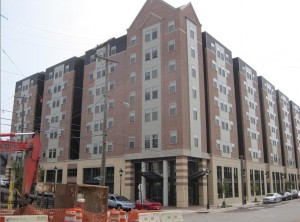
Gilbane Development’s project along Belvidere is one of several new housing options for VCU students outside of the Fan District
Virginia Commonwealth University is important to Richmond. With total enrollment in excess of 30,000, VCU’s economic engine drives a disproportionate percentage of the Metro’s income and impacts much of Richmond in increasingly deep ways. Educating many in our workforce, incubating many entrepreneurial efforts, fostering much of our creative spirit and providing some of our most gripping athletic accomplishments, VCU is more integral to Richmond than arguably any other entity.
The Fan District, VCU’s first neighborhood to the west, shares a somewhat contentious and suspicious relationship with its large and powerful neighbor. In the early 1990’s, Dr. Eugene Trani was named president and brought with him a vision for VCU that included growth in both academic fields and physical space. It also included heavy reliance on the private sector to provide housing for the student population.
In order for VCU to realize its goals of growth, it needed to figure out which direction it should grow. The Fan District, with the highest property values of any bordering neighborhood and most organized and vocal neighborhood association, did not offer the wide swath of undeveloped (or underdeveloped) property upon which VCU could vastly increase its footprint. VCU saw opportunity to the north (Carver) and to the east (Monroe Ward) despite having to cross major thoroughfares (Broad Street and Belvidere Street, respectively) to accomplish their objectives. The Siegel Center and School of the Arts were built along the north side of Broad Street (Carver) while both the new Business School and the East Engineering School (Monroe ward) were built across Belvidere. As the school expanded, so did the need and corresponding development of housing for VCU students.
For much of its existence, housing for VCU’s students was provided by the older tenement styled walk up apartment buildings throughout the Fan. Most of the student population gravitated to the lower end of the apartment market and inhabited the unrenovated (or poorly renovated) properties throughout the district. Students are never the most responsible tenants and landlords with little incentive to renovate or enforce responsible behavior created tension amongst those in the Fan who sought stability and a more serene urban experience.
With the aggressive expansion, private housing development followed the academic and athletic development and created more viable housing options in both Carver and Monroe Ward. These new housing options outside of the Fan combined with the condominium conversion movement of the later 2000’s meant a change in student behavior and a removal of many substandard Fan apartments from the mix. This migration of the student population elsewhere was a positive for the Fan and is in the process of spurring growth in other neighborhoods that had languished without development momentum for decades.
The bottom line is that VCU’s influence on the Fan is far more positive than the prior decades. While students still populate many apartments throughout the district, the density is far lower than it was and the combination of more diligent enforcement of responsible student behavior and newer housing options in other neighborhoods has largely decreased tensions. VCU is a big neighbor whose positives now greatly outweigh the negative influences of yesteryear.
Rick Jarvis is one of the Founders of the One South Realty Group in Richmond, Virginia. He can be found at Google+ and Twitter
